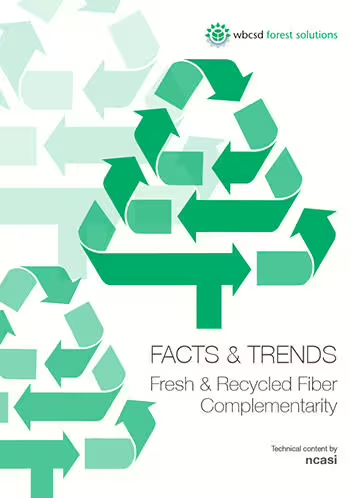Facts & Trends: Fresh & Recycled Fiber Complementarity
Published: April 12, 2015

Fresh or recycled fiber, either-or? The answer is both!
Have you ever wondered if it is more sustainable to use paper products made from fresh or recycled fiber? It is a fair question to ask, but a question that cannot be answered with either-or. In fact, fresh and recycled fiber are part of single-integrated wood fiber system. Fresh fiber needs to be harvested to sustain that cycle. Positive impacts and effectiveness of recycling depend on how much usable fiber can be recovered. The environmental attributes of fresh and recycled fiber are difficult to compare because both complement each other in a single system.
Why does this matter?
Demand for wood and fiber is expected to increase for the foreseeable future. Using natural resources responsibly and transparently is key to meeting this demand. Recovery and recycling is an integral part of using resources efficiently, reducing consumption footprints, providing sustainable products and thereby contributing to creating more sustainable lifestyles.
Forests provide us with a renewable and highly recyclable raw material – wood. Fiber obtained from wood is used to make paper and other products. Given resource constraints, the recovery and recycling of wood and paper products are essential to make a resource-efficient, quasi-circular economy a reality.
Decisions about the purchase and use of wood, fresh and recycled fiber can have wide-ranging consequences on environmental, social and economic values of forests and other natural resources. Making informed choices is imperative for all businesses in building and retaining consumer confidence in their product offerings, including the use of paper, packaging and other fiber based materials.
With this Facts & Trends report the WBCSD Forest Solutions Group aims to demonstrate the complementarity of fresh and recycled fiber for the sustainable supply of renewable raw material and products, outline environmental tradeoffs between choosing between fresh and recycled fiber and emphasize how to maximize the value of each harvested tree.
Developed by the WBCSD Forest Solutions Group with extensive technical support from the National Council for Air and Stream Improvement (NCASI), it supports the ongoing dialogue with major users of forest-based products, in particular consumer-goods companies, WBCSD members and other forest-focused stakeholders in government, civil society and business. It complements the WRI & WBCSD Sustainable Procurement Guide for wood- and paper-based products.